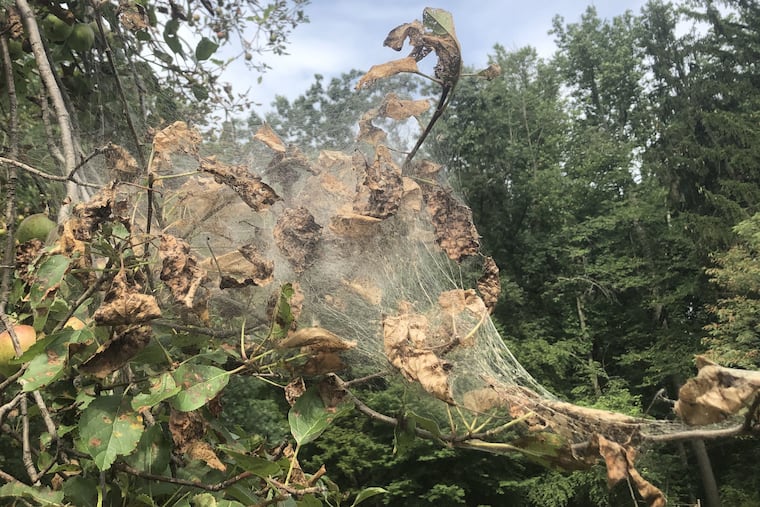What are all those silky white webs covering trees in the Philly region?
They dominate the landscape around Pennsylvania roads in and around Philly: Hundreds, if not thousands, of trees covered in huge masses of white webs.

The silky white webs now appearing by the thousands, dominating the landscape along many of Pennsylvania’s scenic roads, might be ugly as they dangle from stripped, browned branches, but they aren’t a serious threat to the collective canopy.
Some might mistake the webs as a return of the dreaded gypsy moth, but they are instead the work of the fall webworm — a type of moth that seems to have emerged last month in force.
“What you’re seeing is a native insect,” said Don Eggen, forest health manager for the Pennsylvania Department of Conservation and Natural Resources. “It happens to be a good year for them. They periodically do this. And we really don’t do anything about it.”
Gypsy moths, Eggen notes, do their damage in the spring and don’t form large webs.
Hyphantria cunea, or fall webworm, is a pest of shade trees and shrubs from late summer and into early fall, according to Pennsylvania State University’s department of entomology. They attack hickory, walnut, birch, cherry, and crabapple trees. The species is similar to the eastern tent caterpillar, but builds its nests at ends of branches, not in tree crotches.
The large webs they build contain caterpillars, dead partially eaten leaves, and fecal droppings.
They are both widespread in the Philadelphia area and present across the state. For example, on a recent weekend, they covered tree after tree along the roads in and around French Creek State Park in Chester and Berks Counties.
“It’s a caterpillar that feeds on foliage,” Eggen said. “It really likes black walnut trees.”
Eggen noted that the spotted lanternfly, an invasive pest, also likes the same trees. So an infestation of both can be a double blow to a black walnut struggling for its life.
» READ MORE: The spotted lanternfly, prevalent in Pennsylvania, invades South Jersey
Mostly, Eggen said, the fall webworm partly defoliates trees by attacking the trees in the summer when they have full canopies — unlike gypsy moths, which attack in the spring when trees are more vulnerable. Eggen said gypsy moths have not been a threat in recent years, and are unlikely to be so in the coming spring.
“A late-season defoliator causes much less damage,” Eggen said.
Webworms spend winter as a pupa in cocoons hidden in the ground or elsewhere. The adults appear in mid-June, with females laying eggs under leaves.
The larvae hatch within a week and spin a silken web over the leaves they eat. As they mature, the web gets bigger and bigger to enclose more foliate, sometimes encapsulating up to three feet of branch.
And they leave damage behind from the defoliation. Rarely do they kill a tree.
But to homeowners or those out for a Sunday drive, they can ruin a garden or landscape.